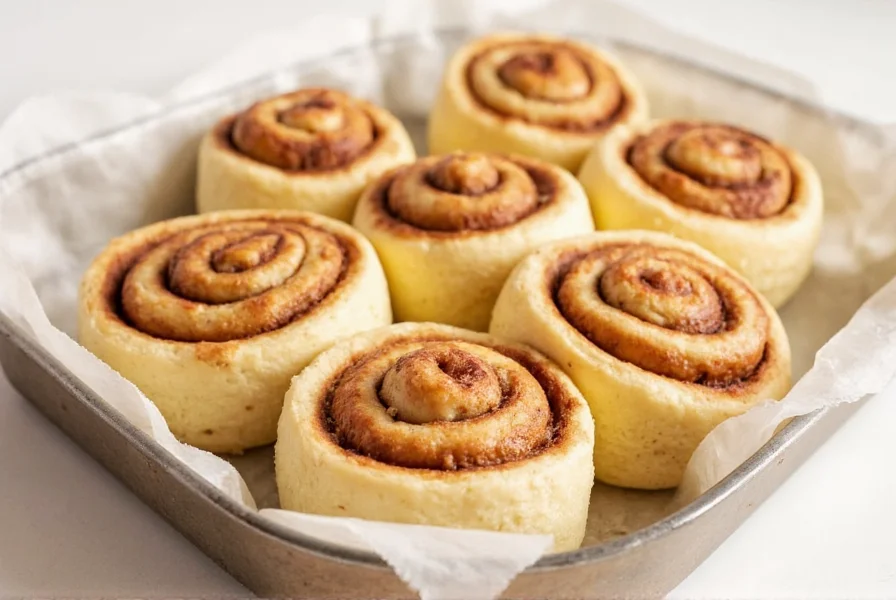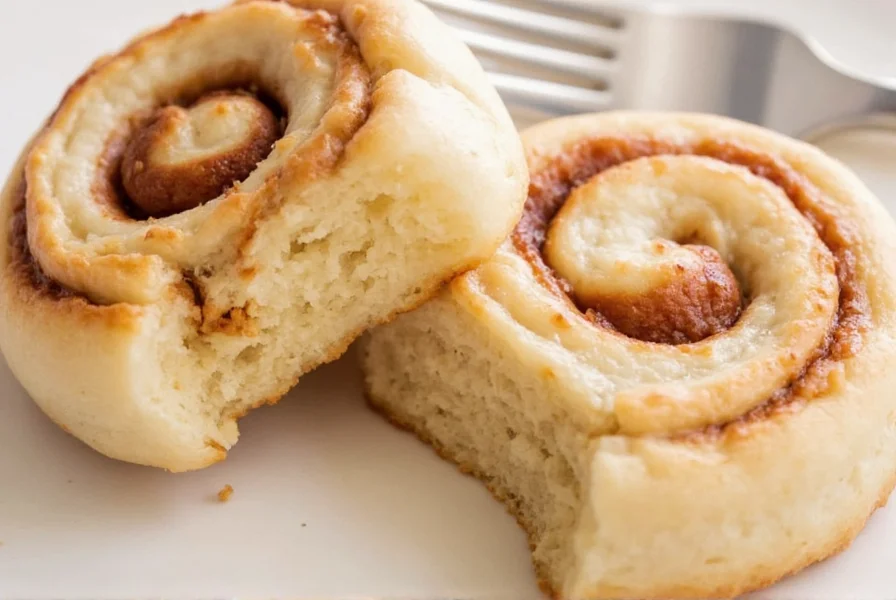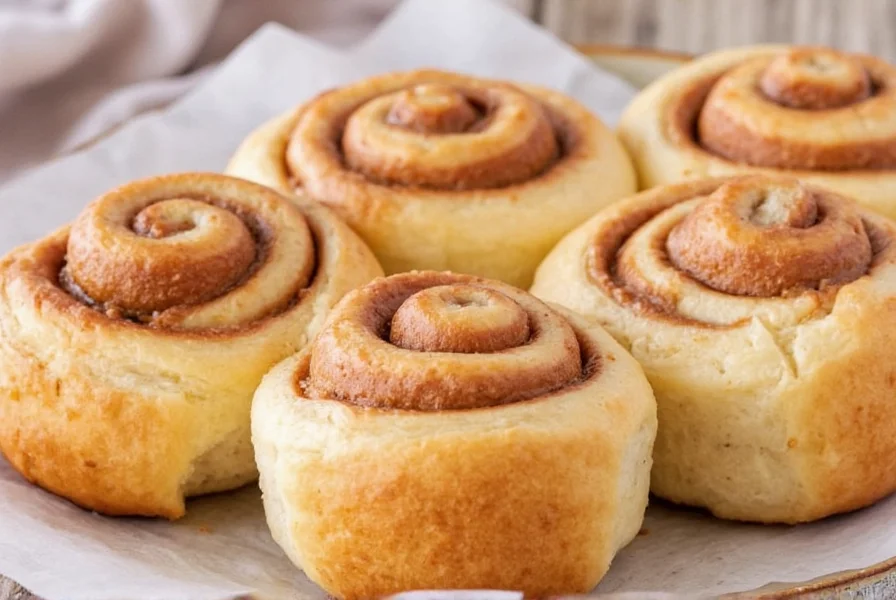Creating perfect yeast-free cinnamon rolls is simpler than you might think. This no-yeast approach delivers bakery-quality results with minimal effort and no waiting for dough to rise. Unlike traditional recipes requiring 2+ hours, these rolls go from mixing bowl to oven in just 30 minutes, making them ideal for last-minute cravings or unexpected guests.
The Science Behind Yeast-Free Cinnamon Rolls
Traditional cinnamon rolls rely on yeast for that characteristic airy texture, but yeast requires time—often 2-3 hours—for proper fermentation and rising. Our yeast-free alternative uses a strategic combination of baking powder and baking soda to achieve similar results through chemical leavening.
Baking powder provides immediate lift when mixed with wet ingredients, while baking soda reacts with the acidic brown sugar in the filling to create additional lift during baking. This dual-action approach mimics yeast's rising effect without the waiting period. The resulting rolls have a slightly denser crumb than yeast versions—more like a cross between a muffin and traditional roll—but with equally delicious flavor.

Essential Ingredients Explained
Understanding why each ingredient matters helps you achieve perfect results every time with this homemade cinnamon rolls no yeast recipe:
| Ingredient | Function | Critical Substitutions |
|---|---|---|
| All-purpose flour | Provides structure | 1:1 gluten-free blend (add 1 tsp xanthan gum) |
| Baking powder | Primary leavening agent | Must be fresh (not expired) |
| Baking soda | Secondary lift from acid reaction | None—critical for texture |
| Cold butter | Creates flaky layers | Chilled coconut oil (dairy-free) |
| Brown sugar | Acidic component for soda reaction | White sugar (less lift, sweeter) |
Step-by-Step Recipe for Perfect Yeast-Free Rolls
Follow these detailed instructions for foolproof homemade cinnamon rolls without yeast. This easy no yeast cinnamon roll recipe yields 12 perfect rolls.
Dough Preparation
- Whisk together 3 cups all-purpose flour, 1/4 cup granulated sugar, 2 tsp baking powder, 1/2 tsp baking soda, and 1/2 tsp salt
- Cut 1/2 cup cold butter into small cubes and work into flour mixture using pastry cutter until pea-sized crumbs form
- Mix 3/4 cup buttermilk and 1 large egg, then stir into flour mixture just until combined (do not overmix)
- Turn dough onto floured surface and gently knead 5-6 times until cohesive
- Roll dough into 16x12 inch rectangle (1/4 inch thick)
Filling and Assembly
- Spread 1/4 cup softened butter evenly over dough
- Mix 1/2 cup brown sugar and 2 tbsp cinnamon, then sprinkle evenly over butter
- Tightly roll dough starting from long edge, pinch seam to seal
- Cut roll into 12 equal pieces using dental floss or serrated knife
- Place rolls in greased 9x13 inch baking dish, cover, rest 10 minutes
Baking Instructions
- Preheat oven to 400°F (200°C)
- Bake rolls 18-22 minutes until golden brown and center rolls test clean
- Cool 5 minutes while preparing icing
- Mix 1 cup powdered sugar, 2 tbsp milk, 1 tbsp melted butter, and 1/2 tsp vanilla until smooth
- Drizzle icing over warm rolls
Troubleshooting Common Issues
Even with this straightforward homemade cinnamon rolls no yeast recipe, you might encounter these common problems:
- Dense or heavy rolls: Overmixing the dough or using expired baking powder. Mix just until combined and verify leaveners are fresh.
- Dry or crumbly texture: Too much flour or not enough fat. Measure flour correctly (spoon and level) and ensure proper butter quantity.
- Rolls spreading too much: Dough too warm. Keep ingredients cold and work quickly.
- Insufficient rise: Inactive baking powder. Test by mixing 1 tsp with hot water—should bubble vigorously.

Storage and Reheating Tips
Proper storage maintains freshness of your quick homemade cinnamon rolls without yeast:
- Room temperature: Store in airtight container for up to 2 days
- Refrigerator: Keeps for 5 days—reheat in microwave 15-20 seconds
- Freezer: Wrap individual rolls in plastic, then foil; freeze up to 3 months. Thaw at room temperature 1 hour before reheating.
- Best reheating method: 10-15 seconds in microwave followed by 2 minutes in 350°F oven restores freshness better than microwaving alone.
Why This Recipe Works Better Than Others
Many baking powder cinnamon rolls recipes fail because they treat the substitution as simple 1:1 replacement. Our approach considers the complete chemical reaction needed:
- The buttermilk's acidity activates baking soda while providing tender texture
- Cold butter creates steam pockets during baking for flakiness
- Brown sugar's molasses content reacts with baking soda for optimal rise
- Resting the cut rolls before baking allows gluten relaxation for better expansion
This method produces the best yeast free cinnamon rolls with texture approaching traditional versions while eliminating the 2+ hour waiting period. The rolls have a slightly denser crumb—more like a professional bakery's "quick bread" version—but with equally rich cinnamon flavor.
Frequently Asked Questions
Can I make these cinnamon rolls gluten-free?
Yes, substitute a 1:1 gluten-free flour blend for the all-purpose flour and add 1 teaspoon xanthan gum to the dry ingredients. Ensure your baking powder is gluten-free certified. The texture will be slightly denser but still delicious—many testers prefer the gluten-free version's chewiness with this no yeast cinnamon roll recipe.
Why do my no-yeast cinnamon rolls taste bitter?
Bitterness typically comes from expired baking powder or too much baking soda. Always use fresh leaveners (test baking powder by mixing 1 tsp with hot water—it should bubble vigorously). For this homemade cinnamon rolls no yeast recipe, precise measurements are critical: use 2 tsp baking powder and only 1/2 tsp baking soda. Never substitute baking soda for baking powder or vice versa.
How can I make these rolls even quicker?
For the fastest preparation of quick homemade cinnamon rolls without yeast, prepare the dough the night before. Mix dry ingredients, cut in cold butter, then store in refrigerator. In the morning, simply add wet ingredients, roll, fill, and bake. You can also use a food processor for faster dough preparation—pulse 10 times after adding butter to flour mixture.
Can I use regular milk instead of buttermilk?
Yes, but you'll need to create a buttermilk substitute by adding 3/4 tablespoon white vinegar or lemon juice to regular milk and letting it sit 5 minutes. Buttermilk's acidity is crucial for activating the baking soda in this yeast free cinnamon rolls recipe. Without the acid reaction, your rolls won't rise properly and will have a denser texture.
Why are my rolls spreading out instead of rising up?
This happens when the dough is too warm. Keep all ingredients cold, especially the butter and buttermilk. Work quickly when rolling and cutting, and place the baking dish in the refrigerator while oven preheats. For best results with this easy no yeast cinnamon roll recipe, maintain cold temperatures throughout preparation—the cold butter creates steam pockets during baking that help the rolls rise vertically rather than spreading horizontally.











 浙公网安备
33010002000092号
浙公网安备
33010002000092号 浙B2-20120091-4
浙B2-20120091-4